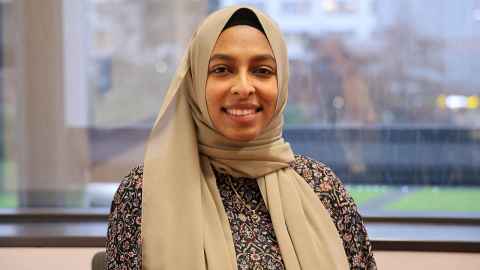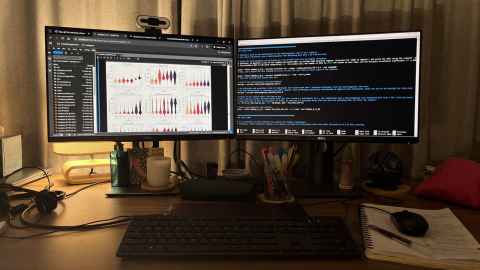Using AI to reshape lung disease diagnosis
15 September 2025
What if we could predict chronic lung disease years before symptoms appear? Liggins Institute researcher Dr Roan Zaied is using machine learning to do just that.

Roan Zaied’s journey with respiratory disease began in childhood, shaped by severe asthma attacks that often ended up with her in hospital.
The asthma eventually went away, but as Zaied began her studies in biomedical science, her experiences stayed with her.
“Asthma is heterogeneous - diverse. There’s childhood onset, adult onset, allergic and non-allergic, exercise-induced etc. But despite different types of asthma having different underlying biologies, much frontline management of the disease is standardised.”
Doctors often give the same medication to patients with different types of asthma, she says.
“But you would expect different types of asthma would benefit from different types of treatments.”
“An estimated 5-10 percent of people do not respond to their asthma treatments. We think this may be because asthma isn’t just one disease, and the same medicines don’t work equally well for everyone.”
Over the last few years, researchers have started to look at what factors can influence asthma, and how to find out the best treatment for a particular individual. Zaied’s PhD, at the University of Auckland’s Liggins Institute, focussed on heredity.
“By studying genetics, we hope to find genes linked to different types of asthma. This could help develop treatments that target those genes, so people get the right therapy for their specific kind of asthma.”
The machine learning model I’ve built was able to predict chronic obstructive pulmonary disease with an 86 percent ability.
This sort of research and treatment has come to be known as ‘precision’ or ‘personalised’ medicine - medical care designed to produce maximum benefit for particular patients or groups of patients, depending on the specifics of their situation.
In the last couple of years, Zaied's focus has stayed with personalised medicine, but she’s switched from looking at asthma to chronic obstructive pulmonary disease, or COPD.
COPD is a serious lung disease that is the fourth leading cause of death worldwide and affects an estimated 15 percent of New Zealanders over 40. It is often caused by smoking, but genetics and other environmental exposures also play a role.
At the moment, COPD is diagnosed using a spirometer breathing test, which measures how much air you can expel and how fast you can expel it. But this is a one-size-fits-all measure, Zaied says, and it also means people are often diagnosed too late.
“Once someone has an abnormal spirometry test, irreversible damage has already occurred to their lungs. And given there is no cure for COPD, finding a way to diagnose it earlier, and also to predict someone’s individual risk for COPD, would really benefit patients – potentially preventing them getting the disease or ensuring they didn’t get such a bad form of the disease.”

Zaied’s task is to use machine learning – a form of artificial intelligence (AI) that learns patterns from data – to personalise someone’s health profile and, through that, predict who might be at risk from chronic obstructive pulmonary disease.
Zaied started with a large existing database of 10,000 smokers who have been followed up over five years. Around half of the participants had COPD at the start of the study, and the other half didn’t. Using the AI, she combined three types of data about people in the database: genetic data, to estimate someone’s inherited risk; CT scans, to detect subtle changes in lung tissue, even before symptoms appear; and clinical risk factors like age, sex and smoking history.
“I have used machine learning to bring this information together, as it's pretty good at picking up patterns that could distinguish COPD from non-COPD individuals. The machine learning model I’ve built was able to predict COPD with an 86 percent ability.
"The next stage is testing the model to see if it can predict COPD in the five-year follow-up, which would constitute true prospective risk prediction."
That would mean Zaied should be able to take the learnings from the people in the database and use the model for other people who might be at risk of developing COPD.
“By using this data, I want to be able to develop a way to predict, detect and diagnose COPD for individual patients in the future.”
Dr Roan Zaied spoke at the recent Liggins public lecture on precision health and AI. Watch the video.
She also spoke to Milly Smyth and Rosetta Stone, presenters of bFM’s Ready Steady Learn show. Listen to their conversation.
Media contact
Nikki Mandow | media adviser
M: 021 174 3142
E: nikki.mandow@auckland.ac.nz